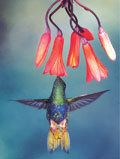A forest in danger
 Colourful Puffleg Eriocnemis mirabilisCredit: Luis Mazariegos(Size: 91.51 kb) |
The tropical forest is the principal habitat of hummingbirds. However, every year, millions of hectares of this forest are destroyed and converted into agricultural land. The causes of deforestation are difficult to control: poverty, demographic growth, greed, the search for power. Although stopping deforestation in the near future seems highly unlikely, hopefully there will be improvements to forest protection and management, and political reform. The population of some tropical species is declining to critical levels that could lead to extinction. This is the case for the Colorful Puffleg (Eriocnemis mirabilis), a hummingbird living in the rain forests of Colombia and the Hook-billed Hermit (Glaucis dohrnii), which is on the Convention on International Trade in Endangered Species (CITES) list of endangered species.
Adaptation
 Anna's Hummingbird Calypte annaCredit: Mike Baird(Size: 59.51 kb) |
The requirements of hummingbirds in terms of habitat are not well known. Many species demonstrate remarkable adaptability, easily adjusting to human intervention and extending their range when feeding conditions are favourable. This has been observed with the Anna's Hummingbird (Calypte anna). Some species have even benefited from the development of agriculture and people's passion for gardening and bird-watching. With the installation of feeders, we see more hummingbirds than ever.
Precautions
 Ruby-throated Hummingbird Archilochus colubrisCredit: Serge Beaudette(Size: 64.28 kb) |
Fermentation is a biochemical reaction that takes place when sugar is present. When wine is made, bacteria in the yeast transform the sugar in the grapes into alcohol. Avoid bacteria-laced water in your feeders. Feeder solutions must be made from boiled water and replaced weekly. The feeder must also be well washed with hot water before refilling it. Hummingbirds that drink fermented nectar can develop cirrhosis of the liver!
|

